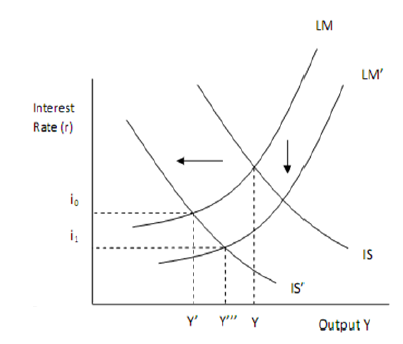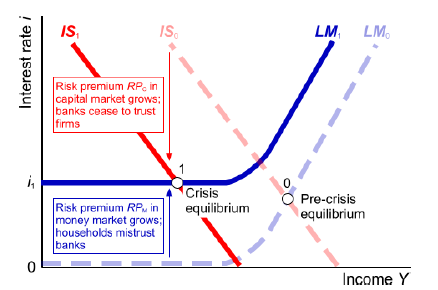Mundell-Fleming Model as more relaxed version of ISLM
Great Depression is rightly perceived as the main stimulating factor behind the emergence of Keynesian framework and ISLM model and the model proved effective to deal with the crisis to a certain extent. However, a set of significant shortcomings associated with ISLM model such as neglecting expectations, static nature of the model, unrealistic closed-economy assumption, assuming prices to remain fixed etc. have led to the evolution of alternative models.
Proposed by Robert Mundell and Marcus Fleming, the Mundell-Fleming model represents an economic model that explains the nature of relationship between the nominal exchange rate and the output of the economy in the short run. Traditionally, this model has been used to justify the argument that maintenance of fixed exchange rate, movement of free capital and independent monetary policy in a simultaneous manner is impossible to achieve. The main difference between Mundell-Fleming model and ISLM model relates to the fact that while ISLM model is effective under a closed-economy, Mundell-Fleming model attempts to analyse an open-economic system. In other words, unlike ISLM, impacts of international finance and international trade are acknowledged in Mundell-Fleming model.
Different countries respondent the global economic crisis of 2007 – 2009 differently taking into account unique set of internal and external factors, however, macroeconomic responses to the crisis by many developed counties can be effectively explained with the use of ISLM model. Dramatic decline in the level of consumer spending which also caused the decline of consumer confidence in markets has facilitated the shift of IS curve in ISLM model to the left. Range of responses by governments to this event included reducing the level of interest rates significantly. For example, interest rates were reduced in US, UK and Japan to 0.25 per cent, 0.5 per cent and 0.1 per cent respectively.
Reduction of the level of interest rates and increasing the level of liquidity in economy helps to offset the leftward shift of the IS curve, at the same time aiming to maintain the level of output at point ‘Y’ as illustrated in Figure 1
Moreover, the application of expansionary measures by governments can be specified as effective anti-crisis measure because real interests rates can be maintained in an adequate levels and LM curve can be offset from upwards shifts.
Large-scale government spending programs were initiated though fiscal policies in majority of developed countries so that effects of the crisis could be effectively mitigated. Appropriateness of such as measures can be explained by the application of ISLM model in a way that increase in the level of government spending pushes IS curve to the right side increasing the level of output.
It is important to stress that the implications of difference between Mundell-Fleming and ISLM models vary according to the size of the economy. To be more specific, difference between Mundell-Fleming and ISLM models tends to be of a lesser extent in large economy compared to small economy because autarky of large open economy is similar to small closed economy to a certain extent.
Moreover, ISLM model accepts the level of interest rate as a critically important element in terms of achieving adequate equilibrium between money market and product market. For Mundell-Fleming model under the circumstances of small economy, on the other hand, changes on the level of nominal exchange rate is accepted as an effective tool to achieve equilibrium in money and product markets because interest rate is fixed.
It has to be noted that Mundell-Fleming model does not address all the shortcomings of Keynesian framework. For example, both, Mundell-Fleming and ISLM models assume price levels to be fixed which may not be the case in real-life market situation and this fact compromises the validity of both approaches. Moreover, Mundell-Fleming model also fails to address the shortcoming of ISLM model related to neglecting manipulations with money supply by central banks and in several other ways.
Liquidity traps can be specified as an effective instrument within ISLM model that is often referred to when linking the model to the global economic and financial crisis of 2007 – 2009. Moreover, risk premium is an alternative notion that needs to be addressed when facilitating a linkage between ISLM model and the crisis. Risk premium emerged in a wide range of financial areas during the last few years prior to the crisis and this fact can be specified as a major factor that enabled the emergence of the crisis in the first place.
The role of banks within ISLM model can be specified as a link between two separate markets – money market and capital market. The rationale behind such a viewpoint relates to the fact that ‘I’ within ISLM model denotes two distinct types of interest rates simultaneously.
Money market rate is used by financial institutions in order to facilitate payments to households and other entities within the national economy in order to achieve optimisation of liquidity. Interest rate, on the other hand, relates to the provision of long-term finances to private sector organisations within the national economy. Importantly, in a situation where banks are restrained from charging more than their capital costs market rate would equal to interest rate. Financial crisis is associated with decrease of the level of trust of public towards banks and this fact increases the level of risk premium to a considerable extent.
Accordingly, Figure 2 below offers three important insights:
Firstly, economy may enter liquidity traps at strongly positive interest rates due to financial crisis and substantial increase of premium risks. Moreover, a satiation may emerge during a crisis where interest rates may increase even during the formation stage of liquidity traps.
Secondly, benefits effects to be derived from monetary policy during the times of financial crises are limited. As it has been stressed above, liquidity traps are usually triggered by financial crises and monetary policies may prove to be ineffective even when the presence of liquidly is not evidently visible.
Thirdly, fiscal policies are effective tools to deal with financial crises in times of liquidity traps, however, the choice of fiscal policies are associated with two substantial disadvantages. The first disadvantage relates to increase in the level of interest rates with an attempt to prevent the decline of income. Increasing level of government debt to be resulted from deficit spending marks the second substantial disadvantage of fiscal policy.
Open-economy paradigm of Mundell-Fleming model has been subjected to criticism by a number of economists. For example it has been argued that “introduction of liquidity preference undermines the celebrated Mundell proposition on the inefficiency of fiscal policy under flexible exchange rates even when the country is a net creditor in the international capital market” (Ohyama, 2007, p.17).
Assumption of perfect mobility of financial capital can be specified as another point of criticism associated with Mundell-Fleming open-economy model. Specifically, while certain pattern of mobility of financial capital is an undisputable attribute of an open-economy, assuming that the pattern of mobility will be ‘perfect’ for each open market neglecting market-specific differences is an obvious limitation of Mundell-Fleming model.
References
Gartner, M. & Jung, F. (2009) “The macroeconomics of financial crises: How risk premiums, liquidity traps and perfect traps affect policy options” University of St. Gallen
Ohyama, M. (2007) “The Mundell-Fleming Model Revisited: A Microeconomics” Keio Economic Studies, Vol.44, Issue 1.


